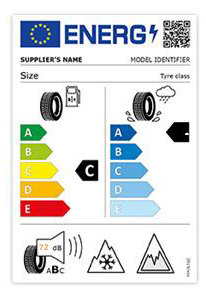What is a tyre label?
As of 01-05-2021, the European tyre label has been revised. This new European tyre label applies to passenger car tyres (C1), light commercial vehicle tyres (C2), and heavy commercial vehicle tyres (C3).

The new mandatory European tyre label must be displayed on the tyre or at the points of sale of all C1, C2, and C3 tyres manufactured from May 1, 2021. The label shows how fuel-efficient, environmentally friendly, and safe the tyre is. It also indicates the performance of tyres specifically designed for use in severe snow and ice conditions. The tyre label enables comparison of tyres with the aim of encouraging the use of safer, more fuel-efficient, and quieter tyres.
Although there are 50 performance criteria to assess the quality of a tyre, the label displays only five. Some examples of all the performance criteria include: wear resistance (kilometer efficiency), braking on dry roads, traction on snow, lateral grip on ice, in-vehicle noise production, handling, and aquaplaning.
Tyre label information: performance criteria
The tyre label provides a value (class) for the following criteria:
Fuel Efficiency
There are 5 classes from A (most efficient) to E (least efficient).
A vehicle’s fuel consumption depends on factors such as the type of engine, speed, road surface, weather conditions, etc. Tire rolling resistance accounts for approximately 20% of fuel consumption. Lower fuel consumption means lower fuel costs and less CO2 emissions. The difference between class A and class G can be up to 7.5% for passenger cars (C1) and up to 15% for commercial vehicle tyres (C3).
Grip on snow
For tyres with the snow symbol, they meet the minimum snow grip index values specified in UNECE Regulation No 117 and are suitable for use in heavy snow conditions. The snow symbol can be found on winter tyres and many all-season tyres.
Grip on wet roads
5 classes from A (shortest braking distance) to E (longest braking distance).
A tyre’s grip on wet roads may vary due to factors such as vehicle type, weather conditions, and tread pattern. Good grip is essential for safety.
Grip on ice
Tyres with the ice symbol meet the minimum grip index values and are suitable for use in very heavy snow and ice conditions.
The ice symbol can only appear on labels for passenger car tyres for the time being.
Rolling noise emission
3 classes of external rolling noise level, measured in dB.
External rolling noise refers to the traffic noise generated by the tyre. In addition to the sound level in decibels (dB), the pictogram also indicates the sound level as A, B, or C.
Note: There is no direct correlation between external (outside the car) and internal (inside the car) tyre rolling noise.
The EU has a so-called “European Product Database for Energy Labelling (EPREL)”. Since 1 May 2021, tyre (label) data can be consulted in the database. There is also a QR code on the tyre label that will eventually make the product data sheet data, as named in Annex III of Regulation (EU) 2020/740, available to everyone.
Referring to said European Regulation (EU) 2020/740, we emphasise that first and foremost, driver behaviour determines fuel consumption and road safety, and in particular that:
- Ecologically responsible driving can significantly reduce fuel consumption;
- Tyre pressure should be checked regularly to optimise fuel efficiency and wet grip;
- Tracking distances should always be strictly observed
This regulation does not apply to:
- Professional off-road tyres;
- Tyres designed to be fitted only to vehicles first registered before 1 October 1990;
- T-reserve tyres for temporary use;
- Tyres in the speed category below 80 km/h; (e) Tyres with a nominal rim diameter of less than 254 mm or more than 635 mm;
- Tyres fitted with traction-enhancing devices, such as studded tyres;
- Tyres designed to be fitted only to vehicles intended solely for racing;
- Second-hand tyres, unless imported from a third country. EN Official Journal of the European Union L 177/6 5.6.2020;
Source: Regulation (EU) 2020/740 of the European Parliament and of the Council
